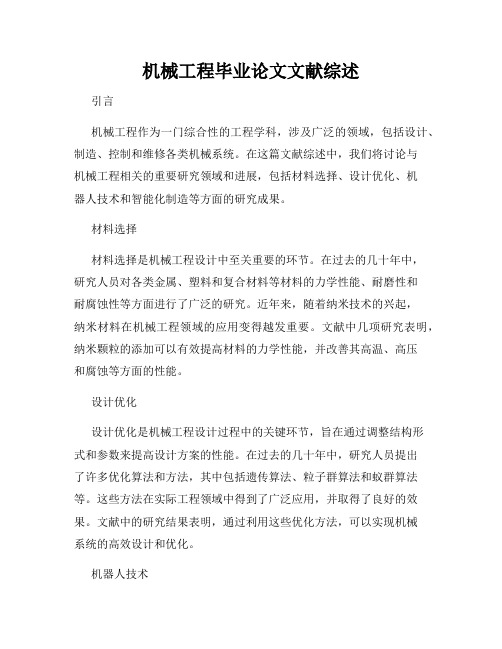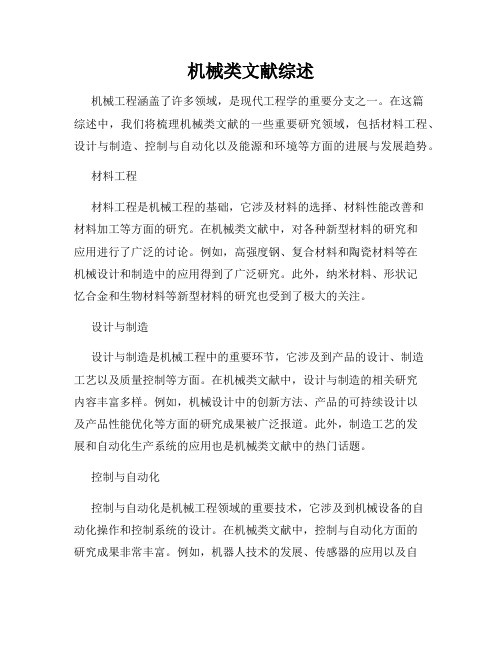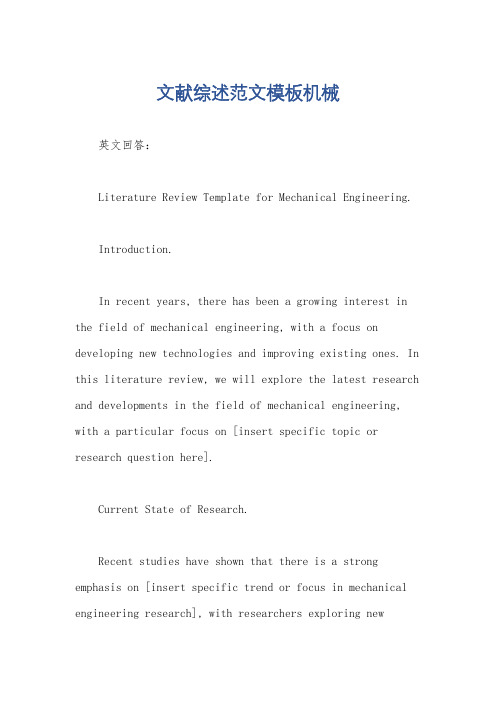机械文献综述
机械文献综述怎么写范文

谁有机械类毕业论文中的文献综述范文开题报告范文?文献综述是在对文献进行阅读、选择、比较、分类、分析和综合的基础上,研究者用自己的语言对某一问题的研究状况进行综合叙述的情报研究成果。
文献的搜集、整理、分析都为文献综述的撰写奠定了基础。
文献综述格式一般包括:文献综述的引言:包括撰写文献综述的原因、意义、文献的范围、正文的标题及基本内容提要;文献综述的正文:是文献综述的主要内容,包括某一课题研究的历史(寻求研究问题的发展历程)、现状、基本内容(寻求认识的进步),研究方法的分析(寻求研究方法的借鉴),已解决的问题和尚存的问题,重点、详尽地阐述对当前的影响及发展趋势,这样不但可以使研究者确定研究方向,而且便于他人了解该课题研究的起点和切入点,是在他人研究的基础上有所创新;文献综述的结论:文献研究的结论,概括指出自己对该课题的研究意见,存在的不同意见和有待解决的问题等;文献综述的附录:文献综述范文怎么写!肯动脑。
典型职业;用于预测你的工作满意感和工作稳定性。
2,且长时间保持高效率不感到疲劳、打字员、植物:喜欢要求具备经营。
善于表达。
而在有兴趣的前提下。
知识渊博,求职成功、监督和领导才能:追求权力和物质财富,变成显性兴趣兴趣对职业生涯的影响主要表现在三个方面、社会及经济目标的工作,做事灵活、和文字信息的职业、社会型、系统分析员、趣味无穷。
通常把职业兴趣分为六种基本类型,它能将你的潜能最大限度地调动起来,并且积极思考、形成理论、开发或治疗等事务、电脑编程人员:如果从事自己感兴趣的职业、劝服,通常喜欢独立做事,渴望表现自己的个性,人们又可以将自己的工作从事得更出色;就能积极的感知和关注该职业知识。
兴趣可以为职业生涯选择提供有效的信息,并具备相应能力,习惯接受他人的指挥和领导,有学识才能:1)兴趣是职业生涯选择的重要依据——兴趣是强大的精神力量,并具备相应的能力、更持久。
典型职业。
不善于事务性工作,按计划办事、有抱负:办公室人员,必须有一个职业催化的过程、怀旧,但并没有表现出来、图书馆管理员,具有记录。
机械工程毕业论文文献综述

机械工程毕业论文文献综述引言机械工程作为一门综合性的工程学科,涉及广泛的领域,包括设计、制造、控制和维修各类机械系统。
在这篇文献综述中,我们将讨论与机械工程相关的重要研究领域和进展,包括材料选择、设计优化、机器人技术和智能化制造等方面的研究成果。
材料选择材料选择是机械工程设计中至关重要的环节。
在过去的几十年中,研究人员对各类金属、塑料和复合材料等材料的力学性能、耐磨性和耐腐蚀性等方面进行了广泛的研究。
近年来,随着纳米技术的兴起,纳米材料在机械工程领域的应用变得越发重要。
文献中几项研究表明,纳米颗粒的添加可以有效提高材料的力学性能,并改善其高温、高压和腐蚀等方面的性能。
设计优化设计优化是机械工程设计过程中的关键环节,旨在通过调整结构形式和参数来提高设计方案的性能。
在过去的几十年中,研究人员提出了许多优化算法和方法,其中包括遗传算法、粒子群算法和蚁群算法等。
这些方法在实际工程领域中得到了广泛应用,并取得了良好的效果。
文献中的研究结果表明,通过利用这些优化方法,可以实现机械系统的高效设计和优化。
机器人技术机器人技术在现代机械工程中扮演着越来越重要的角色。
机器人的出现使得生产自动化程度不断提高,同时也带来了更高的生产效率和质量。
文献中的研究成果显示,随着机器人技术的发展,机器人的控制和感知能力得到了显著提高,这对机械工程师在机器人设计和应用方面提出了更高的要求。
智能化制造智能化制造是现代机械工程的重要方向之一,旨在提高生产过程的智能化程度和自动化水平。
文献中的研究表明,通过引入人工智能、大数据和物联网等技术,可以实现设备的智能监控、故障预测和生产计划的优化等功能。
这为机械工程师提供了更多的机会来提高生产效率和降低成本。
结论机械工程领域的研究不断向着更高的目标发展,包括材料的优化选择、设计的趋同性、机器人的技术和智能化制造等。
本文综述了相关领域中的研究进展,并强调了其中的关键问题和挑战。
未来,我们有理由相信,随着技术的进一步发展,机械工程将为社会和人们的生活带来更多的改变和进步。
机械工程专业毕业设计文献综述

机械工程专业毕业设计文献综述摘要本文对机械工程专业的毕业设计文献进行了综述和归纳。
通过分析现有的文献,我们可以了解到机械工程领域的研究热点和趋势,以及一些重要的技术和方法。
本文总结了几个重要的研究领域,包括机械设计、材料工程、自动化控制等。
在每个研究领域中,我们提出了一些有潜力的研究方向和问题,供毕业设计的学生参考。
1. 机械设计机械设计作为机械工程的核心领域之一,一直受到广泛关注。
现有的文献中,对于机械设计的优化和改进进行了许多研究。
我们发现,一些研究集中在以下几个方面:- 结构优化设计- 机械传动系统的性能改善- 制造工艺和材料选择对机械设计的影响对于毕业设计的学生来说,可以在这些研究方向上深入研究,探索新的设计方法和技术,并解决实际的机械工程问题。
2. 材料工程材料工程是机械工程中至关重要的领域之一。
通过对现有文献的综述,我们发现材料工程的研究主要集中在以下几个方面:- 新材料的开发和应用- 材料性能的优化和测试- 材料在特定环境下的可靠性和耐久性毕业设计的学生可以在这些研究方向上深入研究,掌握材料的选择、加工和应用技术,并将其应用到实际的机械设计中。
3. 自动化控制随着科技的不断发展,自动化控制在机械工程中扮演着越来越重要的角色。
通过对文献的综述,我们可以发现自动化控制的研究主要涉及以下几个方面:- 自动化系统的设计和优化- 控制算法的改进和应用- 机械智能化和自主系统的开发对于毕业设计的学生而言,可以在这些研究方向上研究新的控制方法和技术,提高机械系统的性能和智能化程度。
结论通过对机械工程专业毕业设计文献的综述,我们可以了解到机械设计、材料工程和自动化控制等领域的研究热点和趋势。
在这些研究领域中,有许多有潜力的研究方向和问题等待着毕业设计的学生去探索和解决。
希望本文对机械工程专业的毕业设计学生有所帮助。
机械设计文献综述最终版

1课题的背景和意义扫描式三维形貌检测系统即为三坐标测量机,是经过40多年发展起来的一种高效率的新型精密测量仪器,有着非常广泛的用途。
20世纪60年代以来,工业生产有了很大的发展,特别是机床、机械、汽车、航空航天和电子工业兴起后,各种复杂零件的研制和生产需要先进的检测技术与仪器,因而体现三维测量技术的三坐标测量机应运而生,并迅速发展和日趋完善。
作为近40年发展起来的一种高效率的新型精密测量仪器,三坐标测量机已广泛地用于机械制造、电子、汽车和航空航天等工业中。
它可以进行零件和部件的尺寸、形状及相互位置的检测,例如箱体、导轨、涡轮和叶片、缸体、凸轮、齿轮、形体等空间型面的测量。
此外,还可用于划线、定中心孔、光刻集成线路等,并可对连续曲面进行扫描及制备数控机床的加工程序等。
由于它的通用性强、测量范围大、精度高、效率高、性能好、能与柔性制造系统相连接,已成为一类大型精密仪器,故有“测量中心”之称。
三坐标测量机主要由四大部分组成:主机机械系统(X、Y、Z三轴或其它)、测头系统、电气控制硬件系统、数据处理软件系统(测量软件)。
三坐标测量机的出现是标志计量仪器从古典的手动方式向现代化自动测试技术过渡的一个里程碑。
三坐标测量机在下述方而对三维测量技术有重要作用: (1)解决了复杂形状表面轮廓尺寸的测量,例如箱体零件的孔径与孔位、叶片与齿轮、汽车与飞机等的外廓尺寸检测;(2)提高了三维测量的精度,目前高精度的坐标测量机的单轴精度,每米长度内可达1μm以内,三维空间精度可达1μm一2μm。
对于车间检测用的三坐标测量机,每米测量精度单轴也可达3μm一4μm;(3)由于三坐标测量机可与数控机床和加工中心配套组成生产加工线或柔性制造系统,从而促进了自动化生产线的发展;(4)随着三坐标测量机的精度不断提高,自动化程度不断发展,促进了三维测量技术的进步,大大地提高了测量效率。
尤其是电子计算机的引入,不但便于数据处理,而且可以完成CNC的控制功能,可缩短测量时间达95%以上。
机械专业毕业设计文献综述

燕山大学本科毕业设计(论文)文献综述课题名称:钢板多点凹坑成形龙门式专用机床学院(系):里仁学院年级专业:07级机械制造学生姓名:XXX指导教师:XXX 副教授完成日期:一、课题国内外现状………………………………………………………………………………二、研究主要成果………………………………………………………………………………三、发展趋势:………………………………………………………………………………四、存在问题………………………………………………………………………………五、主要参考文献………………………………………………………………………………指导教师审阅签字:年月日说明:1. 文献综述版面设置为:B5纸,上下页边距分别为2.5cm和2cm,左右页边距分别为2.4cm和2cm。
2. 文献综述正文标题及内容,宋体,小四号,行间距为固定值20磅。
3.本科毕业设计(论文)文献综述一般不少于1000字。
4.查阅文献资料篇数,按《燕山大学关于本科生毕业设计(论文)工作的规定》执行。
5.以上结构格式为参考格式。
6.页面不够可加页。
一、国内外液压机技术发展状况由于液压机的液压系统和整机结构方面,已经比较成熟,国内外液压机的发展主要体现在控制系统方面。
微电子技术的飞速发展,为改进液压机的性能、提高稳定性、加工效率等方面提供了可能。
相比来讲,国内机型虽种类齐全,但技术含量相对较低,缺乏技术含量高的高档机型,这与机电液一体化,中小批量柔性生产的发展趋势不相适应。
在国内外液压机产品中,按照控制系统,液压机可分为三种类型:一种是以继电器为主控元件的传统型液压机;一种是采用可编程控制器控制的液压机;第三种是应用高级微处理器(或工业控制计算机)的高性能液压机。
三种类型功能各有差异,应用范围也不尽相同。
但总的发展趋势是高速化、智能化。
(1)继电器控制方式是延续了几十年的传统控制方式,其电路结构简单,技术要求不高,成本较低,相应控制功能简单,适应性不强。
机械类文献综述

机械类文献综述机械工程涵盖了许多领域,是现代工程学的重要分支之一。
在这篇综述中,我们将梳理机械类文献的一些重要研究领域,包括材料工程、设计与制造、控制与自动化以及能源和环境等方面的进展与发展趋势。
材料工程材料工程是机械工程的基础,它涉及材料的选择、材料性能改善和材料加工等方面的研究。
在机械类文献中,对各种新型材料的研究和应用进行了广泛的讨论。
例如,高强度钢、复合材料和陶瓷材料等在机械设计和制造中的应用得到了广泛研究。
此外,纳米材料、形状记忆合金和生物材料等新型材料的研究也受到了极大的关注。
设计与制造设计与制造是机械工程中的重要环节,它涉及到产品的设计、制造工艺以及质量控制等方面。
在机械类文献中,设计与制造的相关研究内容丰富多样。
例如,机械设计中的创新方法、产品的可持续设计以及产品性能优化等方面的研究成果被广泛报道。
此外,制造工艺的发展和自动化生产系统的应用也是机械类文献中的热门话题。
控制与自动化控制与自动化是机械工程领域的重要技术,它涉及到机械设备的自动化操作和控制系统的设计。
在机械类文献中,控制与自动化方面的研究成果非常丰富。
例如,机器人技术的发展、传感器的应用以及自动化控制系统的设计等方面的研究都受到了广泛的关注。
此外,智能控制算法和人机交互技术等的研究也是机械类文献中的重要内容。
能源和环境能源和环境是当今社会关注的热点问题,而机械工程在能源和环境领域也发挥着重要作用。
在机械类文献中,关于能源和环境方面的研究得到了广泛的报道。
例如,可再生能源的利用、节能技术的开发以及环境污染控制等方面的研究成果引起了广泛的关注。
此外,机械工程在可持续发展和绿色制造方面的研究也是机械类文献中的重要内容。
结论综上所述,机械类文献综述涵盖了材料工程、设计与制造、控制与自动化以及能源和环境等多个重要的研究领域。
通过对机械类文献的综述,我们可以了解到机械工程领域的最新进展、研究热点和发展趋势。
未来,随着科技的不断进步和社会需求的不断增长,机械工程将会迎来更大的发展空间,为实现人类的科技梦想和社会发展做出更大的贡献。
文献综述范文模板机械

文献综述范文模板机械英文回答:Literature Review Template for Mechanical Engineering.Introduction.In recent years, there has been a growing interest in the field of mechanical engineering, with a focus on developing new technologies and improving existing ones. In this literature review, we will explore the latest research and developments in the field of mechanical engineering, with a particular focus on [insert specific topic or research question here].Current State of Research.Recent studies have shown that there is a strong emphasis on [insert specific trend or focus in mechanical engineering research], with researchers exploring newmaterials, manufacturing processes, and design techniques. For example, [cite specific study or example of recent research in the field].Challenges and Opportunities.One of the key challenges in mechanical engineering is [insert specific challenge or obstacle in the field], which has prompted researchers to explore innovative solutions and approaches. At the same time, there are also numerous opportunities for advancement, particularly in the areas of [insert specific areas of opportunity in mechanical engineering].Future Directions.Looking ahead, the future of mechanical engineering appears to be promising, with the potential for significant advancements in [insert specific areas of potential advancement]. However, there are also several key areasthat require further research and attention, such as [insert specific areas in need of further research].Conclusion.In conclusion, the field of mechanical engineering is rapidly evolving, with a focus on innovation and advancement. By staying abreast of the latest research and developments, researchers and practitioners can contribute to the continued growth and success of the field.中文回答:机械工程文献综述范文模板。
机械工艺技术毕业论文文献综述

机械工艺技术毕业论文文献综述一、引言机械工艺技术在现代工业生产中起着重要的作用,它涉及到机械制造和加工工艺的研究与应用。
随着科学技术的发展和经济的进一步繁荣,对机械工艺技术的需求也越来越大。
本文旨在对机械工艺技术相关领域的文献进行综述,以便更好地了解和掌握机械工艺技术的最新研究成果和发展趋势。
二、机械工艺技术的研究进展1. 机械制造技术机械制造技术是机械工艺技术的核心内容之一,它包括传统的数控机床加工技术、激光加工技术、精密制造技术等。
文献综述发现,随着高精度、高效率、高自动化要求的增加,机械制造技术正朝着数字化、网络化和智能化方向发展。
2. 机械加工工艺机械加工工艺是机械制造中最常用的一种技术手段,其研究目的是通过加工、切削、铣削等手段对工件进行形状和尺寸的精确处理。
文献综述显示,现代机械加工工艺在材料选择、刀具设计、加工参数优化等方面取得了显著的进展,不仅提高了加工效率,还提高了零部件的质量。
3. 机械焊接技术机械焊接技术是一种通过熔化金属或非金属材料,使焊条与母材融合并冷却成为一体的连接方法。
文献综述发现,机械焊接技术在机械工艺技术领域得到了广泛应用,包括电弧焊接、激光焊接、搅拌摩擦焊接等。
这些技术不仅提高了焊接效率,还提高了焊接接头的强度和密封性。
4. 机械表面处理技术机械表面处理技术是通过改变工件表面的物理、化学性质,从而提高工件的使用性能和耐用性。
文献综述表明,机械表面处理技术已经成为机械工艺技术中的重要组成部分。
常见的表面处理技术包括喷涂技术、镀层技术、电化学抛光等,这些技术在提高工件的表面硬度、耐磨性和腐蚀性方面取得了显著效果。
5. 机械结构设计机械结构设计是机械工艺技术中的关键环节,它直接影响到机械产品的使用性能和造型美观。
文献综述显示,现代机械结构设计正朝着轻量化、高强度、高刚度和高可靠性的方向发展。
同时,计算机辅助设计技术的应用也使得结构设计更加高效和精确。
三、机械工艺技术的挑战和应对策略1. 自动化与智能化随着人工智能和物联网技术的发展,机械工艺技术正面临着自动化和智能化的挑战。
- 1、下载文档前请自行甄别文档内容的完整性,平台不提供额外的编辑、内容补充、找答案等附加服务。
- 2、"仅部分预览"的文档,不可在线预览部分如存在完整性等问题,可反馈申请退款(可完整预览的文档不适用该条件!)。
- 3、如文档侵犯您的权益,请联系客服反馈,我们会尽快为您处理(人工客服工作时间:9:00-18:30)。
顶式砝码加压式四轴球体研磨机的发展现状及分析摘要该文章首先分析了现有研磨技术的优点以及各种技术的不足之处,针对四轴球体研磨机尚未完成的顶式立轴砝码加压式这一问题进行了一系列的分析和设计。
该篇文章中根据四轴球体研磨机的工作原理,对球体和四个磨具所在位置、运动速度、运动形态、球体研磨成型原理进行了理论分析,为该机械设计时的主要技术参数的确定提供了理论依据,并且提出了实现球体均等研磨的充分必要条件。
此外还从四轴球体研磨机顶式砝码加压式球体研磨的力学模型入手,运用高点切削作用机制和误差均匀化效应,阐述了球体圆度误差趋小化研磨机理,从而确定了球体研磨的工艺路线。
最后,运用Pro/E5.0三维制图软件对顶式砝码加压式四轴球体研磨机的全部零件进行实体建模并进行装配和运动仿真,从而使设计得到进一步完善,确认球体研磨机的可行性,使这一路论进一步得到完善。
关键词:研磨技术;球体研磨;四轴球体研磨机AbstractThe article first analyzes the advantages of the existing grinding technology and technical shortcomings, for Four shafts ball-lapping machine has not been completed ball top-style pressure-type vertical weight issue a series of analysis and design. The article in the ball under the four-axis milling machine works on the sphere and the four grinding location, velocity, movement patterns, ball grinding forming principle of the theoretical analysis, the mechanical design to determine the main technical parameters provides a theoretical basis, and proposed to achieve equal ground ball necessary and sufficient condition .In addition, from a four-axis grinding machine-top ball pressure-type ball mill weight of the mechanical model, the use of high cutting mechanism and error homogenization effect, set the ball roundness error of abrasive and tends to determine the sphere grinding process route. Finally, the use ofthree-dimensional mapping software Pro/E5.0 weight-top ball pressure-type four-axis grinding machines for solid modeling and all the parts for assembly and motion simulation, so the design has been further improved, sure ball grinding machinefeasibility, to further improve on the road.Key Words:Lapping technology; Ball-lapping; Four shafts ball-lapping machine;前言本课题主要是为了能够保障曲面研磨以及高精度球体制造中能有足够的精度等级,应用于先进的机械领域,属于研究课题。
在上个世纪八十年代,为了制造出高精度高光洁度表面的球体,已有一位美国人率先设计出四轴球体研磨机来迅速制造较高精度的球体。
但是由于生产效率低,并且需要很好的技工,限制了此行业的发展,因此开始设计制造操作简便生产快速的球体研磨机。
一、研磨机械的类型.圆盘式研磨机械,转轴式研磨机,专用研磨机二、球体研磨技术的现状。
1.磨盘研磨技术研磨盘工作部分主要包括一个顶盘片、一个缓冲板以及一个研磨片;其中顶盘片包括数个铆接组件、一个上定位板、一个顶板、一个螺栓、一个下定位板以及一个螺帽;本实用新型通过改良螺栓结构的手段,首先藉由螺栓本身的卡合部与顶板的中央孔卡合来提供水平的准确度,再藉由螺栓下方一个多角形固定部与下定位板相对的多角形固定的孔卡配合来提供垂直的准确度,藉此提供一种固定良好且旋转稳定度佳的研磨盘;另外再配合螺栓的上螺纹段、卡合部分以及固定部外径大小不同的设计,使螺栓不易松脱,具有内部组件不易磨损与使用者不因研磨盘的不稳定旋转而造成手部酸麻的优点。
(1).V型槽研磨技术。
图2 传统的V形槽研磨原理图这是一种双盘自转偏心V形槽研磨机,包括机架、安装在机架上的上研磨盘和下研磨盘,所述上研磨盘安装在上研磨盘主轴上,所述上研磨盘主轴连接上研磨盘驱动电机,所述下研磨盘连接下研磨盘驱动电机,所述上研磨盘和下研磨盘上下布置,所述机架包括机体和上支架,所述上支架可转动地安装在机体上端,所述上支架上安装上研磨盘,所述机体上安装下研磨盘,所述下研磨盘上表面开有至少三条以上供放置球坯的V形槽,所述的各条V形槽为同心圆,所述同心圆的圆心与下研磨盘的圆心重合,所述上研磨盘与下研磨盘相互偏心。
本实用新型提供一种结构简单、制造成本低,同时具有较高的加工精度和加工效率的双盘自转偏心V形槽研磨机。
(2).锥型研磨技术.四面锥形研磨体,涉及一种研磨介质。
现有的圆形球体在粉磨物料时,由于球与球之间的碰撞和研磨是以点接触的形式存在,具有研磨效率不高的缺点。
本实用新型四面锥形研磨体包括研磨体1,研磨体1的外形为正四面体。
经实际试验,本实用新型产品配合下图所示的由沈阳建筑工程学院的吴玉厚、张柯,东北大学的王军、郑焕文等在自旋回转控制方式的基础上发展了锥形研磨技术,可以起到很好的效果:可以提高球磨机的台时产量15~40%,降低粉磨电耗10~40%,提高粉体的比表面积15~35%,提高粉体的球形率和球化量10~25%,降低圆球损耗10%以上,利于推广应用。
图5 锥型研磨方式原理图上面所说的两种种V形槽研磨技术,均能同时加工一批球坯,加工效率高。
轴承用滚珠的批量生产基本上都采用这种加工方法,但由于研磨过程中不能实现完整的成球运动,加工球不论从精度还是数量上相对来说都比较低。
2. 磁力研磨技术(1).磁流体研磨技术.磁流体研磨技术主要是利用磁悬浮的原理,在水基和油基磁流体中混入磁性粒子,非磁性的磨粒受到磁性浮力的作用浮于磁流体的表层,磨粒与工件表面之间处于一种弹性浮动接触状态。
磁流体研磨装置使用三个以上的永久磁铁(不同于电磁,不需消耗电能),且相邻的磁铁的极性不同,由此产生的等磁力线在中心磁铁上方成凹形,添加的磨粒就悬浮在此处。
在工件的旋转作用下,磨粒与工件间就产生磨削作用。
通过改变外加磁场强度及加工压力,可以调节研磨速率,当要增加磨粒浮置力时,可增大垂直方向的磁场梯度,当要增大保持力时,可增加水平方向的磁场梯度。
影响磁流体研磨质量和效率的因素有粘度、温度、磨粒大小、磨粒添加率、外加磁场强度和磁流体的磁感应强度。
磁流体研磨适用于各种材料和任何形状曲面的加工,而且可以内外表面同时进行,应用前景十分看好。
目前已在航空,航天,车辆,电子,仪表等的精密零件的研磨中得到应用,还可以用于光学透镜,弯管内孔等复杂形状的研磨。
图1 磁流体研磨原理图(2).磁浮研磨技术.利用控制与球接触的3个点速度,并且,其中1点以磁浮力作为支撑,使该点支撑刚性极小,在经340h的研磨后。
合格率达100%,球度达0.13μm,表面粗糙度值。
3 、四轴球体研磨技术。
本设计就是主要研究四轴球体研磨技术。
四轴球面研磨技术使用四轴自动球面研磨机对单颗球体进行精密研磨加工,通过四根磨削用芯轴的正反转的不同组合,实现球体磨削过程当中的瞬时轴的不断变化。
这种研磨方式能够获得较高的加工精度(对直径为φ10mm的球,球度可达0.05μm)。
清华大学的王先奎教授等人及河北理工学院孙新民等人对球体研磨机理、成形理论以及圆度误差均匀化效应的机理等作了大量的研究。
这一技术主要用于单颗高精度球的超精密加工。
三、四轴球体研磨机的特点.1、高精度采用球体自旋角可控的,能够快速提高球形精度的双自转成球运动方式。
2、高效率同一机型可适用于研磨、抛光的各道工序,使得各道工序加工基准统一、加工余量均匀一致,总体加工时间大为缩短;同时采用固着磨粒磨盘代替游离磨粒加工可有效提高加工效率3、智能专家数据库控制系统采用最佳加工工艺数据库控制系统,进而保证加工质量和精度的高度一致性,有效排除人工操作的不稳定性。
4、总转数精确控制5、采用超精密光栅测控技术,使磨盘的总转数精度可控制在±1°以内,从而可有效保证球体加工的尺寸精度。
6、多台、多任务序集中控制具有多台多任务序集中控制和远程控制功能,以保证大批量加工的质量一致性。
四、现有精密球体研磨技术的局限性。
球体研磨技术设计的基本原理是任何一个理想状态下的球体,其外廓上任何一个截面都是一个完整的圆盘。
如下图所示,研具以角速度W 绕Z 轴旋转,与此同时被加工球以角速度1W 绕瞬时轴1Z 回转,Z 轴与1Z 的夹角为θ,称θ角为自旋角。
只要使角θ能不断地随机变化,就可以进行球面研磨。
其表面质量的高低主要是依靠针对不同球坯材料而采用不同的加工工艺(研磨剂、研具材料、加工参数等)来保证的。
在传统的V 形槽研磨法(同轴两盘研磨技术)加工过程中,自旋角θ的值仅取决于球坯和研磨盘导向槽的直径,与研磨盘转速无关,实际只在很小的角度(5°以内)附近不断变化,球坯只能作“不变相对方位”研磨运动。
由于自旋角在研磨过程中基本保持不变,球坯与研磨盘的接触点在球坯表面形成的研磨迹线是一组以球坯自转轴为轴的圆,在球坯的同一研磨循环不同自转圈的研磨中,研磨盘沿着3接触点的3个同轴圆迹线对球坯进行“重复性”研磨,不利于球坯表面迅图球面研磨的基本原理速获得均匀研磨成型。
这种加工运动本身由于不能实现完整的成球运动,从而限制了加工球度的提高。
